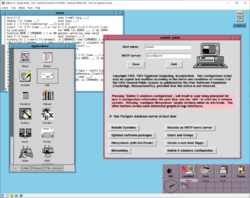Yggdrasil Linux
| Yggdrasil Linux | |
 Yggdrasil Linux running in the 3.1 version of 86box emulating an ASUS P/I-P55T2P4 | |
| Creator: | Adam J. Richter |
|---|---|
| Architecture: | i386 |
| Date Released: | 1992 |
Yggdrasil Linux/GNU/X, also known as Yggdrasil or LGX, is an early Linux distribution that could be considered the first live CD Linux distribution. It describes itself as a “Plug-and-Play” Linux distribution, automatically configuring itself for the hardware. Yggdrasil, named after Norse mythology's world tree, aimed to provide a complete Linux system on a single CD.
The LGX name is said to be named after three of its principal components: the Linux kernel, the GNU software suite, and the X window system.
Contents
Releases
There were 6 releases of Yggdrasil however you can only download 5 of them from here...
1992 Alpha
The 1992 alpha release was announced on the 25th of November 1992. The first release was on the 8th of December, 1992. The CD-ROM was in the ISO-9660 filesystem meaning you could view the contents from DOS, other Unix systems and Macintoshes as per the mailing list(?)
This release contained the following software on the CD-ROM:
- Linux 0.98.1 kernel,
- X windows (v11r5) for VGA displays with support for higher resolutions such as 1024x768 256 colors using the ET4000, ET3000, Paradise, or Genoa chip sets, and the standard Xlib/Xt development environment,
- GNU utilities, including GNU C and C++, the GNU debugger, bison, flex, GNU make,
- TeX and groff typesetting packages,
- Ghostscript: a postscript interpreter that can drive a variety of printers and also display in an X window,
- elvis and GNU emacs text editors,
- kermit 5A telecommunications program, and
- an installation script that uses the extended filesystem, which supports long filenames and symbolic links just like the BSD file system,
- iso9660 filesystem with support for the Rock Ridge extensions for reading CDROM's (used by this CDROM distribution),
- lots of other useful programs too numerous to mention.
A 386/486 CPU, 8MB RAM, high-density floppy, 100MB IDE, SCSI or ESDI disk (200MB with sources), SCSI CDROM drive with an Adaptec 1542B, Ultrastor 14F, Future Domain TMC-1660/1680, Seagate ST01/02, or Western Digital 7000fasst SCSI controller were required for this version of Yggdrasil. The alpha distribution consists of the CDROM, and 3.5" and 5.25" high-density bootable filesystem floppies.
The alpha release was missing some of the source code of some of the packages, that being because Adam states on the announcement thread "The main limitation that I had to deal with in the alpha release was that a tar file of the initial CDROM filesystem had to fit on my 200MB disk. I won't have this limitation when I cut the beta release, so /usr/src will be much more complete. It is my intention to eventually be able to build the CDROM by saying "cd /usr/src ; make install""
1993 Beta
Fall 1993
This release contained the following software/updates on the CD-ROM as per the announcement:
- important version numbers: 0.99.13 kernel, Xfree86 1.3, GCC 2.4.5.
- New Tk/Tcl supports all of the features described in Professor John Ousterhout's upcoming book on Tk and Tcl.
- More software than any competitor: 235MB binaries + 445MB source code.
- Linux 0.99.13 kernel supports most popular CDROM's
- an easy-to-use installation script, plus a graphical user interface for system configuration,
- The X Window System: version 11 release 5, Xlib/Xt X windows libraries, the Tcl/Tk scripting language, the Xview 3.0 OpenLook(tm) toolkit, InterViews C++ toolkit,
- The Andrew System version 5.1, including the ez editor for easy creation and reading of documents with embedded images, equations, spreadsheets, hypertext links, and other media types.
- Ethernet Networking with TCP/IP, NFS and other Internet protocols.
- Games: asteroids, battle zone, chess, mille bornes, othello, pool, shogi, solitaire, tetris, and connect four.
- Multimedia: viewers for JPEG, GIF, TIFF and other image formats, MPEG video, sound,
- Text editors: the elvis vi clone, GNU Emacs with calc mode, and Lucid GNU Emacs (better graphical user interface).
- Desktop Publishing: TeX and groff typesetting packages with X previewers, and ghostscript, a postscript interpreter for X windows, faxes and a variety of printers,
- Telecommunications: kermit, Z-modem, Taylor UUCP, mail reader, threaded USENET News reader, with support for reading MIME multimedia messages with embedded images, full motion video and sound.
- the Postgres 4.1 remote database system,
- Programming Languages: GNU C++, GNU ANSI C, FORTRAN-to-C and Pascal-to-C translators, and Prolog,
- Enhanced development environment: GNU debugger, bison, flex, GNU make, the GNU Coverage Tool, Revision Controls System, Concurrent Version System, and Gnats,
- System V-style shared memory and interprocess communication,
- File Systems: a filesystem with long file names, symbolic links, and FIFO's, iso9660+rockridge CDROM filesystem, DOS filesystem,
- Emulators: a BIOS emulator that can run DOS, an experimental ELF loader, and a snapshot of a WABI Windows emulator under development.
It also states it is competitive with Solaris and Windows NT.